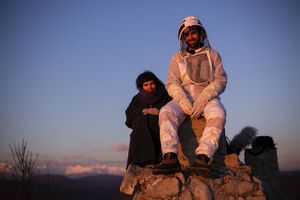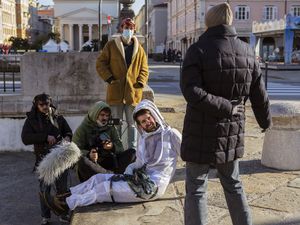Traces Of Light
Online Celebration of the Cultural Holiday 2021
On Kinoatelje's YouTube channel
The central celebration of Slovenes in Italy for the Slovene Cultural Holiday 2021 was entrusted by the umbrella organizations SKGZ and SSO to the Kinoatelje team. The event, titled TRACES OF LIGHT. Within it lies all our life..., premiered online on Monday, February 8, 2021, at 7 PM via Kinoatelje's YouTube channel and was broadcast on February 14 and 18 on the Slovene Program of the RAI Regional Headquarters for Friuli Venezia Giulia. The program was marked by the voice of youth, directed by Leo Černic, with a ceremonial address by architect Vida Rucli.
Kinoatelje seeks to highlight the richness and value of the audiovisual heritage of Slovenes in Italy, emphasizing the need for its proper organization and appreciation. Through moving images, we leave traces of life. Every community, especially a minority one, values its heritage, but projecting into the future is a mature endeavor that requires growth, nurturing, and guidance. While it is easier to connect to established traditions, which seem reliable and lasting, the real work for the future lies in creating something new, reshaping, and transcending the existing heritage. Heritage is testimony and legacy of the past, the wealth of every community—but it must be a springboard, not a constraint. Working for the future means creating new traditions. As our ancestors created their heritage, we too must build a new legacy for the future, which can be captured in the images of film—fragile yet enduring.
Direction and Editing: Leo Černic
Director of Photography: Fabris Šulin
Sound Designer: Havir Gergolet
Second Camera: Urban Košir
Performers: Jan Devetak, Aljoša Žerjal
Team: Majda Bratina, Aleš Doktorič, Martina Humar, Karin Kocijančič, Mateja Sulič, Orjana V. Grbac
Producer: Mateja Zorn
Production: Kinoatelje, February 2021
Trailer
Video of the Celebration
Vida Rucli's Address at the Central Celebration of Slovenes in Italy – Traces of Light, February 8, 2021
Photos from the film shoot
Photos from the press conference at the Gorizia Commercial House, February 2, 2020
ALONGSIDE THE CELEBRATION
THE INVENTION OF FILM
Since the Lumière brothers' locomotive arrived at a Paris station in 1895, moving images have fascinated us. Early filmmakers captured reality and significant contemporary events on delicate, vulnerable celluloid strips. Then Georges Méliès discovered that film cameras could create imaginary worlds, establishing an intangible theater that didn’t require live actors every time. Modern filmmaking oscillates between documentary and fiction, reflecting humanity's dual desires to understand the world and create new worlds of imagination.
FROM FILM TO THE INTERNET
Electronic and online production of moving images hasn't fundamentally altered the essence of film but has simplified its creation. Smartphones have democratized filming, while storage on hard drives or in the cloud still awaits validation of its longevity. The internet has enabled moving images to transcend borders, allowing us to document, communicate, narrate, archive, multiply, and share our traces of life through light and movement. Yet, we often assume that someone else will preserve it all for us.
INFORM AND FORM
The words "inform" and "form" share the same root. Every received piece of information shapes us, influencing our thoughts, words, and actions. Information speaks to our memory, challenges our rational interpretation of events, and offers new material for our reflections. Simultaneously, it shapes our personality and the ways we incorporate moving images into our existential fabric and unique imaginary world.
CHAOS AND COSMOS
Humanity often lives in chaos but believes in cosmos—order—and strives to achieve it on Earth. The cosmos is envisioned as a harmonious universe governed by known and unknown laws. Cosmonauts, whether real or imagined, terrestrial or extraterrestrial, are explorers navigating this orderly universe, pursuing knowledge and building new imaginary worlds.
COMMUNITY AND THE WORLD
Heritage binds people into communities. We can identify with it or challenge it. In exploring and verifying our multifaceted identities, we also respond to the challenges of the world and cosmos, which connect humanity into a global community. Often, world citizens who have moved away from their homeland can offer fresh perspectives to their original communities for the future.
COSMONAUT COSMOPOLITAN
Being a world citizen or cosmopolitan doesn’t mean being uprooted or disconnected. Without knowing who you are and where you're from, you can't connect with others or share deeper experiences and create stronger bonds. Even cosmonauts set off from somewhere and eventually land somewhere after their journeys.
HERITAGE AND TRADITION
Every community, especially minority ones, values its heritage, but projecting into the future requires nurturing and creating something new. Tradition should not be a rigid constraint but a springboard.
HERITAGE FOR THE FUTURE
Those who don't invest in the future act in vain. Archives, libraries, and museums exist not for the past but for the future. The future preserves communities, including the Slovene community in Italy. Like our ancestors who invested in their present to create a legacy, we too must invest in the present to create a new heritage for the future. The present is a fleeting moment bridging the past and future—a transient stop we can capture in moving images that are fragile yet enduring and impactful.
AUDIOVISUAL HERITAGE
Kinoatelje's decades of work in audiovisual culture demand persistence, enhancement, and the establishment of lasting foundations. The audiovisual heritage, especially works created outside professional institutions, must be preserved for future generations to draw from and creatively apply to their projects.
INSTITUTIONS AND CREATIVITY
The Slovene community in Italy possesses institutions that are rare among other communities: schools of all levels, music schools, research institutes, libraries, newspapers, publishers, theaters, radio, and television. It is essential to prevent any of these from fading due to negligence. Audiovisual creation also needs a space, a team, and an institution to support young authors and preserve older works for restoration and promotion.
KINOATELJE (since 1977)
Kinoatelje operates in Italy and Slovenia as a multifunctional hub for intercultural and cross-border projects in audiovisual culture. It organizes events, provides education, conducts research, publishes, produces documentaries, fiction, experimental and animated films, and develops archival and documentation activities. Special attention is given to themes related to the border area between Italy and Slovenia and the Slovene community in Italy.
Compiled by Aleš Doktorič





